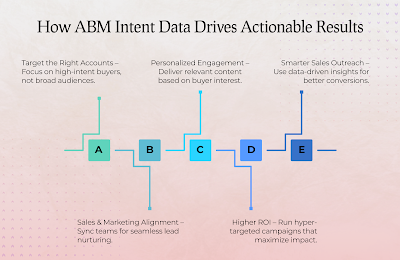Employing a well-organized Lead Nurture Program is crucial in moving potential buyers along the sales funnel. Nevertheless, conventional nurture methods are often shallow and missing the mark, resulting in squandered opportunities and resources. There is, however, predictive B2B intent data that can help businesses drive highly effective targeted campaigns with better engagement and conversion rates.
Understanding Predictive B2B Intent Data
A person’s online activity helps create a picture of their
level of preparedness to purchase something. This is the definition of
predictive intent data. It assists in spotting signals like engagement with
certain content, specific searches, and even checking the competition.
Businesses can use this information to anticipate customer requirements and
tailor the right message that meets their needs in a timely manner.
Key Strategies to Optimize Lead Nurturing with Intent
Data
1. Segment and Prioritize Leads Efficiently
Segmentation based on level of purchase intent is possible
with intent data instead of equitability. Definite intent leads are eligible
for advanced direct engagement while those with a lower level of intent receive
additional nurturing to raise interest levels alongside trust.
2. Deliver Hyper-Personalized Content
The chances of engaging leads with pre-made generic email
sequences are slim to none. Prospect engagement can be improved by many folds
through the use of Intent Data.
Aligned content with what stage the lead has reached in the buying cycle is
what businesses can create and deliver. Personally tailored content such as
industry reports, case studies, or product demos yield greatly enhanced
engagement levels.
3. Enhance ABM Strategies for Precision Targeting
The predictive intent data is an invaluable asset in ABM
Lead Generation as it assists in determining valuable accounts which are
heavily researching for solutions. The marketing and sales teams are then able
to concentrate on those specific accounts making it more efficient with higher
returns.
4. Automate Lead Nurturing Workflows
Intent data can be integrated with marketing automation
tools which allows for real-time lead nurturing. When a lead is highly
demonstrative of buying intent, personalized emails, retargeting ads and even
sales outreach can be triggered as real-time automated workflows.
5. Optimize Sales Outreach for Higher Conversions
Cold outreach is a challenge for many sales teams as it is
very difficult, but sales teams are now able to rely on predictive intent data.
When sales representative knows a prospect is looking for a solution, a
salesperson is always willing to talk because at this time they are armed with
the information necessary to add value.
Measuring Success and Continuous Refinement
Monitoring participation metrics, changes in sales activity,
and lead movement over time can improve the Lead
Nurture Program. A/B testing various content strategies and modifying
outreach schedules according to intent signals can increase effectiveness
further.
Using predictive B2B intent offers multiple advantages
because businesses are able to build a more intelligent and efficient nurture
strategy that results in better quality leads and sales results.
Read More:
1.
How
Can an Intent Data Provider Maximize B2B Content Syndication?
2.
Unlocking B2B Content
Syndication Potential with Intent Data Providers
3.
The
Role of Intent Data Providers in Enhancing B2B Content Syndication
4.
How
Do Intent Data Providers Boost B2B Content Syndication Success?
5.
Leveraging
Intent Data Providers for Better B2B Content Syndication Results

.png)











.png)







